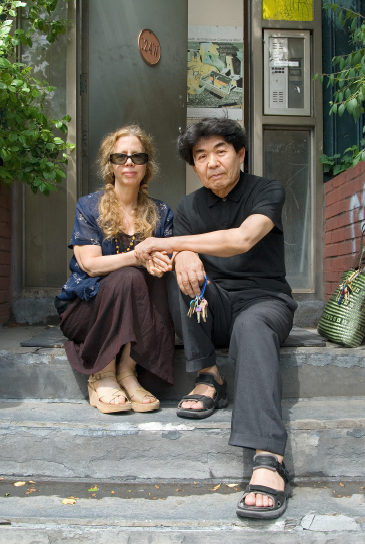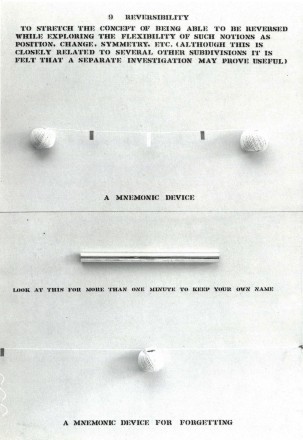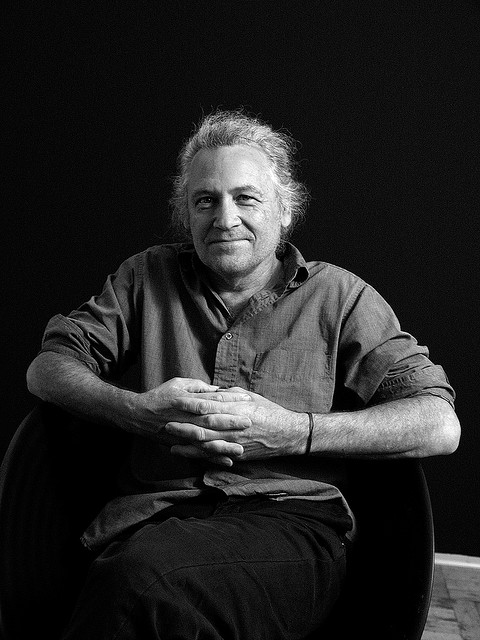Seeing from Between: Toward a Poetics of Interloping
Happenstance (part one of many parts), 1982-83 from Gary Hill on Vimeo.
All men are sisters.
Madeline Gins
Poetry is translation. It takes one kind of experienced or thought reality and turns it into language—a linguality or language reality that is conscious of itself in a way that’s relatively unusual. Of course this is obvious enough, and yet what’s not always so clear is how much the view of language we hold (actively or passively) determines the outcome. I suppose that, due to the attention given rather specialized emphases in recent poetics (language poetry, conceptualism, Oulipo, etc.), poets often find it necessary to takes sides on, or at least defend, values designated by words like “content,” “politics,” “experience”; this is understandable and may be useful to them and others (recent blogs by Camille Rankine and David Lau are particularly strong statements), especially in a context where respected poetic approaches appear exclusive in one way or another. Yet the simple fact that privileged words like “content” and “politics” do not have consistent meaning (beyond what a poet’s own work or a specific social context supplies) indicates that whatever we defend is not necessarily there the way we might believe it is. There are poets, as well, who center their activity at one level or another on this (post-Wittgensteinian) problematic of language, motivated perhaps by a certain vision of language or by a commitment to conscious language as intrinsically transformative. It should be obvious that focus on the substance of language itself does not mean that these poets are not concerned, even passionately, with issues like gender, racial equality, ecology, or the menace of capitalism, militarized police and State power. They may show up at the barricades, even if their work is not written to be read at the barricades.
Significant new directions in poetry have often come from outside the literary frame as such, and this might alert us to how much innovative poetic values and approaches are not only “literary” in nature, but are conscious attempts to embody radically alternative reality views by way of language. (In an important sense poetry is pre-literary, and it is arguably fundamental to the nature of language itself. Literature, in this perspective, is historically later and is constructed on poetic foundations while often running counter to poetic values. We may come to see as well how poetry can be post-literary.) Looked at in this way, poetry may be seen as language you must learn—learn by way of its implicit poetics—in order to participate in alignment with its principles. To see this more clearly I suggest a liminalist approach, one foot in a literary poetic and one foot not.
Consider some of the most poignant interlopers. In the 1960s it was already clear that Buckminster Fuller—identified variously as architect, mathematician, systems theorist, designer, inventor, futurist, writer—was fully operational as poet, and his 1962 Untitled Epic Poem on the History of Industrialization published by poet Jonathan Williams (Jargon) was important, for instance, to John Cage and Fluxus poet Dick Higgins. He felt he served a direct incursion from the “outside” (in a sense perhaps not so different from Jack Spicer’s) and recounted a kind of out-of-body experience in which he claimed to have floated above the ground in a sphere of white light; this experience, he said, impeded his near suicide by declaring to him that he performed a function of Universe (cap, no article). He subsequently called himself a verb (I Seem To Be a Verb, 1970) and an evolutionary process, which of course complicates a sense of personal identity. Consequently he spent his life in pursuit of principles that would guide his thinking, his writing, and his view that a single individual can to some degree alter the course of history. When he needed new words he invented them, like “synergetic,” “tensegrity” (= “tensional integrity”) and “ephemeralization” (= “doing more with less"). He lectured in an unprecedented self-innovating language of long continuing sentences, often using neologisms, including strange compound words (“omni-interaccommodative”). He wrote as he spoke in what he called “mental mouthfuls and ventilated prose.” In my mid-20s, giving a course in experimental poetry at Stony Brook University, I taught his No More Secondhand God and Other Writings (published 1963, the title poem going back to 1940) along with Silence (“Lecture on Nothing”), by another great poetic interloper John Cage, as alternative kinds of poems and as language-thought experiments. These strange poems fundamentally altered my own sense of language.
A major “outside” from which poetry has found renewals is philosophy, which many poets avoid: Charles Olson and Robert Duncan drew heavily from A. N. Whitehead, and David Antin not only worked from Wittgenstein but already in the 1960s argued that Philosophical Investigations is a poem, a view that infused his own work. Many have treated Nietzsche’s Thus Spake Zarathustra as poem (he also wrote verse), and Heidegger wrote his own species of verse. In another domain Nicolai Gogol called Dead Souls a poem. Artists also make alternative poetries, such as Paul Klee; and Marcel Duchamp created a new kind of writing—indeterminately accessible note-like inscriptions in “box” containers—which has been powerfully influential on many poets and artists; and a lot has been written about this as historical “progression.” Among those indebted to what eventually gets characterized as Duchamp’s “conceptualism” is the late Japanese-American artist Arakawa and his partner, the poet Madeline Gins, very recently deceased. But Arakawa, whom Arthur Danto called “the most philosophical of contemporary artists,” cannot justly be subsumed under a category, especially one intended to explain a historical progression (nor in the end, I would argue, can Duchamp), suggesting instead new, virtually inexhaustible possibilities in language, thinking, experience, and in fact life principles. They are among the most instructive in their conscious attempts to embody radically alternative reality views in language. In doing so they alter our conception of both language and poetry.

Arakawa & Gins, photo by Dimitris Yeros, 2008
Arakawa, collaborating pervasively with Gins, created charged language spaces on canvas, poetic action zones that challenge habits of reading, viewing and thinking at a level comparable to Blake’s all-out assault on limits of consciousness. Their 1979 The Mechanism of Meaning: Work in progress (1963-1971, 1978) unites painting and book in a way that creates a powerful event in both visual art and poetics. They have worked conceptually in a way related to both Dada and Duchamp’s developments thereof, but they always focused on an inquiry into certain principles, which they thought to have implications far beyond art alone. In an extraordinary essay (1982) discussing the work of this period, Charles Bernstein and Susan Bee write:
Arakawa deals with the visual field as discourse, modal systems that constitute the world rather than being constituted by it. In this sense, his work is neither a reconstruction of a given visual reality or an ontologically autonomous, “pure,” formalism. Rather, it is a project of inquiry, in which the dialogic and inquisitive become an architecture of visual thinking.
—“Meaning the Meaning: Arakawa’s Critique of Space,” Content’s Dream (1986)

from The Mechanism of Meaning
This is a language-thought experiment guaranteed to fail, but in such a way that the mind is free to choose a path alternative to rationality, an inquiry that may not lead to an answer but to further intricacy of mind-language-experience. It’s an inquiry that points toward life-changing principle (for which see their Reversible Destiny website). As such, it’s an instance of metapoeia, a constructive poetics going beyond its own construction and initiating a process of unexampled attraction. Adding to Pound’s phanopoeia, melopoeia, logopoeia, the metapoetic indicates a poetic determinant beyond the direct effects of sound, image and wordplay alone, requiring a response as well to context, structure, concept, visuality, energy field, including non-literary/non-art principles; the metapoetic can change the rules of the game it is playing. These factors may be present in any kind of work, but in Arakawa/Gins it holds the center of poetic force. It throws the mind into what they name “blank” and “forming blank,” which is something like the meaning equivalent of the empty space of their language-tormented canvas, the mind space that never achieves comprehensive meaning due to a constantly shifting axis of unresolvable focus. Blank is space capable of creating its own source—space at once physical, non-physical, and lingual.
The Arakawa/Gins collaboration is one of the major art/poetic events of our time. It’s no surprise that collaboration itself becomes a revelatory instrument for altering the relationship between reader/viewer and the work. As Gins comments on Arakawa’s painting:
The viewer should be accustomed to knowing in this case that the painting he is looking at was intended to be something that one day would look at him. No longer only a viewer or spectator, not even a correspondent or witness only, once the activity of regarding has been enjoined, the viewer will become a collaborator and as such either a mediator or an experimenter or both. (Emphasis added.)
Madeline Gins is herself a poet of unprecedented challenging works, including Word Rain (or A Discursive Introduction to the Philosophical Investigations of G,R,E,T,A, G,A,R,B,O, It Says) (Grossman, 1969), What the President Will Say and Do!! (Station Hill Press, 1984), and Helen Keller or Arakawa (Burning Books, 1994). What she says above of the viewer’s relationship to an Arakawa painting applies to the reader facing her text; it asks to be enjoined! Here we enter the mind-language world of deaf-blind Helen Keller in the language-imagination of Madeline Gins:
Voice is a ball that only collects into the being of one in the course of something’s being said—a ball made up of nothing but it’s own rolling out. Or voice is a precipitate. Or this is a chain of precipitates of … the whole of my movement? I make it out to be a precipitate that is practically a “photographic” report of mindbody. Voice comes—from head to foot—out the fingers of the right hand, with a lot of talk hanging around the wrist and a light march of it down through the whole length of the middle of the forearm; but lately I have tried to connect this to that pitifully under-used apparatus, my voice box.
—“Perception Has Got to Have a Body,” Helen Keller or Arakawa
All intelligible connection with the world for Helen Keller is a language event occurring physically between her and another person. She + another create together a liminality that is the known/knowing world. Blank is also the space of an indeterminacy of agency: who/what’s doing the doing—what Arakawa/Gins call “the perceiving field.” I think here of Maurice Blanchot’s fiction with a poetics, Thomas the Obscure (Station Hill Press, 1988), in which at a certain point of shifting textual perspectivity it takes us performatively into the book reading the reader. His notion of récit (story, narrative, a telling) has resonance for all of the above: “not the narration of an event, but that event itself, the approach to that event, the place where that event is made to happen."
I would call artist Gary Hill’s video work Happenstance (part one of many parts) (1982-83) (see the beginning of this blog) a kind of récit. This work is something like a drama of unfolding language configuration that narrates its own emergent event as it happens. (I have explored this further in the book written with Charles Stein, An Art of Limina, on Gary Hill and the poetics of time-based art.) In what could almost be an art genre unto itself that works midway between figurative and abstract—let’s call it configurative art—what you see and hear creates a language world. Here’s some of the spoken text from that video:
Vanishing points. Things. Things are going to happen. Happenstance. … The words are coming, listen to them. Nothing surrounds them. They are open, they speak of nothing but themselves with perfect reason. I am talking, I am talking them out into the open. They sit like deer in a field, if I approach them too quickly they fade into the quick of things. Silence is always there – there is silence when I stop to take a breath, when I see breathtaking things.
Gary Hill, photo by Lynn Thompson
Check out this powerful seven-minute poem-piece by Gary Hill, Cutting Corners Creates More Sides (2012):
This visible unfolding linguality raises the question of method and instrumentality in the event. The complexity of one’s relation to a charged space of happening in a medium has many nuanced aspects of “control” and “release” along the self-other continuum. The Arakawa/Gins example of collaboration must be one of the richest on record. Over many years of my own performing with poet/musician/artist collaborators (including Gary Hill, Charles Stein, David Arner, John Beaulieu) what I now call “axial” performance (music, glossodelia), the sense of agency is far too subtle to represent: everyone is following something unrepresentable but perceptibly happening between them. (“Unrepresentable” because axial work engages a principle that relies on no established or predictable patterns.) The directedness is never only within or without, but seemingly anywhere at once in a sort of quantum distributed sense. It’s self-regulating, self-organizing, autopoietic; I think of Peter Lamborn Wilson’s “ontological anarchism” as a related name for axial performance, a conception of attractor for the possibility of social order based on open and accurate listening. Even at it’s pataphysical craziest! Here’s Gary Hill’s filming of Charles Stein and me in a 1985 performance edited in 2008 as Figuring Grounds:
Poet, writer, musician, and artist George Quasha was born in White Plains, New York, and grew up in …
Read Full Biography


